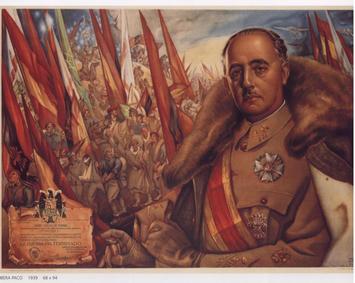The Politics and Ideology of Franco's Party
The Spanish Revolution of the 1930's resulted from a clash of party beliefs. One party; The Popular Front Government, a republican party who had been voted into power, stood against Francisco Franco and his semi-fascist government, which was composed of landowners, monarchists, clergy, fascists, and other fascist party members from other regions of Europe. Franco was supported by Italian and German forces and fought for political control of Spain. His Coup' D' Etat ended when the Popular Front Party collapsed, leaving him at the head of his country.
Directly after assuming the mantle of leader of Spain, Franco dissolved the Spanish parliament, outlawed political parties and group meetings, and set about creating an Authoritarian government. He attempted to control most of Spain's social life, collectivizing shops and stores, limiting freedom of expression, removing universal suffrage, and preventing anti-government talk. He reinstated the Catholic church as the main church of Spain, which is why the clergy backed him in his ascent to power. His perception of society was in mostly military terms, molding his foreign and local policies to be based around retaking key land for Spain and keeping its people in check.
Although Franco could be classified as an absolute leader, many put him in a different category all together. As he didn't seek to completely control social life and the economy, Franco and his government are often referred to as lite-authoritarian or semi-absolute.
Directly after assuming the mantle of leader of Spain, Franco dissolved the Spanish parliament, outlawed political parties and group meetings, and set about creating an Authoritarian government. He attempted to control most of Spain's social life, collectivizing shops and stores, limiting freedom of expression, removing universal suffrage, and preventing anti-government talk. He reinstated the Catholic church as the main church of Spain, which is why the clergy backed him in his ascent to power. His perception of society was in mostly military terms, molding his foreign and local policies to be based around retaking key land for Spain and keeping its people in check.
Although Franco could be classified as an absolute leader, many put him in a different category all together. As he didn't seek to completely control social life and the economy, Franco and his government are often referred to as lite-authoritarian or semi-absolute.

